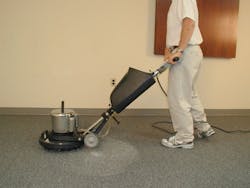How Low Moisture Carpet Cleaning Can be a Green Option
More facilities managers understand the benefits green cleaning products can have on their buildings, from minimizing harmful impacts of custodial workers and occupants, to improving IAQ, to helping receive and maintain a green certification.
One way to incorporate green cleaning into your building maintenance is to start as soon as occupants and visitors walk in: with the carpets.
Low Moisture Carpet Cleaning is a Green Solution
Lonnie McDonald, president of the Low Moisture Carpet Cleaners Association (LMCCA), the nonprofit association for low moisture cleaning, defines green carpet cleaning as a method that:
- Is environmentally friendly or friendlier
- Preserves human health and environmental quality
- Is designed for the environment by EPA standards
- Has an EcoLogo or equivalent standard (e.g. Green Seal, Safer Choice, Design for the Environment)
LMCCA considers low moisture carpet cleaning a green option since compared to a hot water extraction method (i.e. steam cleaning) it uses less moisture and cold water (eliminating the need for power to heat), and requires little HVAC energy for a fast dry time.
A method is low moisture if it has a fast drying time that allows fibers to dry in their natural state in two hours or less at 65% relative humidity and 70 degrees F. This can be accomplished by:
- Using less moisture to clean
- Using absorbent media
- Having higher efficiency vacuums for water extraction
- Increasing the evaporation rate of the carpet
Most commonly accepted low moisture carpet cleaning methods include:
- Encapsulation
- Dry foam
- Dry absorbent media
- Shampoo
- Bonnet or oscillating pad
Low Moisture Carpet Cleaning Done Correctly
McDonald notes that any method can be used in a low moisture application, but it’s more difficult for hot water extraction to qualify as low moisture. “It’s not about the method used, it’s about getting the carpet cleaned and back to its natural dry state,” he says. “However, it’s easier to accomplish that by using a method or combination of methods that use less moisture.”
Related: Reduce Custodian Staff Turnover by Giving Thanks
He says even low moisture carpet cleaning methods done incorrectly can use too much moisture. Finding someone who can clean your carpet effectively for the method you choose is important. “The right method is whatever the user has the most skill in,” McDonald says.
He encourages facilities managers to understand their options for cleaning and what the person who’s cleaning the carpets has skills and experience in. He reminds people that the easiest way to get dirt out of the carpet is by dry vacuuming; otherwise, made wet, the dirt turns into mud, making it very difficult to remove no matter what method you use for cleaning.
“If your building doesn’t have tremendous traffic, you can use low moisture carpet cleaning for years with minimal expense,” McDonald explains, comparing low moisture carpet cleaning to steam cleaning.
Green Cleaning Solutions
Saying a cleaning product is green can mean different things. Have a conversation with your carpet cleaner and do research to ensure you’re getting the type of product you want. McDonald also suggests that facilities managers looking for green carpet-cleaning solutions:
- Look for the labels and standards mentioned above, and if the cleaner talks about a different one, research it.
- Ask the cleaner questions: Do you have LEED experience? Do you have certified green products you use? Confirm that what they tell you is true through research or the EPA website.
- Specify in your contract that you want a green-equivalent product and have the cleaner state what they are using in writing.
“You want to ensure that the chemicals you use are not only green but that they don’t have a propensity to re-soil,” McDonald advises. “If soils, bacteria and bio-pollutants stick to a cleaning chemical after cleaning, that’s re-soil. That’s defeated the reason to use a green product.”
On topic: 4 Biggest Building Maintenance Challenges and Solutions
He suggests testing – on a plate, in a bowl or anywhere – the chemicals that will be used on the carpet first to make sure that at the use dilution ratio, they dry down brittle and come off the surface. If it does, you know you have a product that’s green and won’t re-soil the carpet.
Low moisture systems can clean all types of carpet. McDonald stresses that no matter the method, the best way to clean your carpet is having someone who’s trained and has experience in the method you are using.
Two hand-picked articles to read next:
About the Author

Valerie Dennis Craven
Content strategist and writer
Valerie Dennis Craven is an experienced writer of commercial and residential buildings and interiors, having previously served as Editorial Director for both BUILDINGS and i+s. Valerie enjoys writing about technology and how it impacts users in the built environment.
